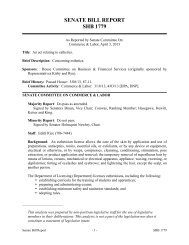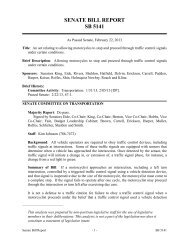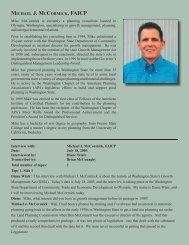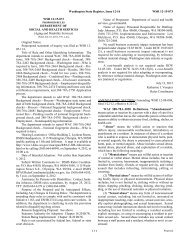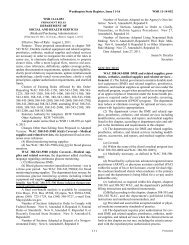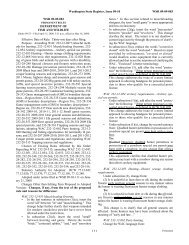Proposed
Proposed
Proposed
You also want an ePaper? Increase the reach of your titles
YUMPU automatically turns print PDFs into web optimized ePapers that Google loves.
(39) The certification mark may be applied to the product<br />
prior to authorizing the use of a certification mark on a<br />
product. The laboratory must:<br />
(a) Determine by examination and/or tests that representative<br />
samples of the product comply with the requirements<br />
(standards). Components of certified products must comply<br />
with the applicable safety requirements (standards) or be<br />
listed. Evaluation of the product design must be made on representative<br />
production samples or on prototype product samples<br />
with subsequent verification that factory productions are<br />
the same as the prototype;<br />
(b) Determine that the manufacturer has the necessary<br />
facilities, test equipment, and control procedures to ensure<br />
that continuing production of the product complies with the<br />
requirements; and<br />
(c) If the certification mark is not applied at the manufacturing<br />
facility, the laboratory must provide prior notification<br />
to the department of its intent to affix the certification mark in<br />
the field.<br />
Certification laboratory product - Assurance/follow up.<br />
(40) To verify continued product acceptability, the laboratory<br />
must develop and maintain a factory follow-up inspection<br />
program and manual to determine continued compliance<br />
of certified products with the applicable standard.<br />
(41) The follow-up inspection file must include the:<br />
(a) Conditions governing the use of the certification<br />
mark on products;<br />
(b) Identification of the products authorized for certification;<br />
(c) Identification of manufacturer and plant location at<br />
which manufacture and certification are authorized;<br />
(d) Description, specifications, and requirements applicable<br />
to the product;<br />
(e) Description of processes needed for control purposes;<br />
(f) Description of the manufacturer's quality assurance<br />
program when used as part of the follow-up program;<br />
(g) Description of inspections and tests to be conducted<br />
by the manufacturer and the laboratory; and<br />
(h) Description of follow-up tests to be conducted in the<br />
laboratory.<br />
(42) Follow-up procedures and activities must include:<br />
(a) Periodic inspections at the factory with testing at the<br />
factory or certification laboratory of representative samples<br />
selected from production and, if appropriate, from the market;<br />
(b) Periodic auditing or surveillance of the manufacturer's<br />
quality assurance program through the witnessing of<br />
manufacturer's tests, review of the manufacturer's records,<br />
and verification of the manufacturer's produced data;<br />
(c) Investigation of alleged field failures upon department<br />
request; and<br />
(d) Procedures for control of the use of the certification<br />
mark by:<br />
(i) Keeping records of the release and use of certification<br />
marks;<br />
(ii) Removal of marks from noncomplying products;<br />
(iii) Return or destruction of unused marks when the<br />
authority to use the marks is terminated; and<br />
(iv) Legal action.<br />
Washington State Register, Issue 12-21 WSR 12-21-103<br />
(43) The frequency of laboratory follow-up inspections<br />
must not be less than four times per year during production,<br />
unless adequate data is provided to the department to justify<br />
less frequent inspections. If there is no production during the<br />
year, at least one follow-up inspection is to be completed.<br />
The frequency of follow-up inspections must be sufficient to<br />
provide a reasonable check on the method(s) the manufacturer<br />
exercises to assure that the product bearing the certification<br />
mark complies with the applicable standards.<br />
Field evaluation - Requirements.<br />
(44) The field evaluation laboratory may perform evaluations<br />
on any products or product categories previously<br />
approved by the department. NRTL recognition may be<br />
accepted by the department as a basis for approval to perform<br />
field evaluations. Since OSHA does not review or recognize<br />
laboratories for field evaluation purposes, laboratories seeking<br />
accreditation from the department for field evaluation<br />
may be required to provide additional justification of capability<br />
such as, but not limited to: Recordkeeping, employee<br />
standards and proficiency, equipment requirements, and<br />
other requirements described in this chapter.<br />
(45) ((The laboratory must request permission from the<br />
department in writing two working days prior to conducting<br />
any field evaluation of an electrical product to be installed in<br />
any jurisdiction in the state. Requests must be made using a<br />
department-supplied form.<br />
(46) The field evaluation process must be completed<br />
within six months following department approval. If the field<br />
evaluation is not completed within six months following<br />
department approval, the laboratory must request permission<br />
from the department in writing to continue the evaluation<br />
process. If this secondary permission is granted to the laboratory,<br />
the department may require the equipment to be placed<br />
out-of-service except as necessary to complete the field evaluation<br />
process.<br />
(47))) The scope of a field evaluation will depend on the<br />
status of the item to be evaluated as follows:<br />
(a) A new piece of equipment must have a complete<br />
evaluation of all components and the assembly as provided<br />
by the manufacturer. For example: An industrial machine<br />
with a control panel, remote motors, sensors, controls, and<br />
other utilization equipment; and<br />
(b) A product that has been modified internally or by an<br />
addition need have only those portions evaluated that were<br />
affected by the modification. For example: A switchboard<br />
with multiple sections that has a section added would only<br />
need the new section, the one section immediately adjacent,<br />
and any control modifications evaluated.<br />
(((48))) (46) Each unit that receives a field evaluation<br />
mark applied by the field evaluation laboratory must have<br />
sufficient inspections and/or testing completed to ensure it is<br />
in essential conformance with the applicable product standard(s).<br />
(((49))) (47) The laboratory may perform the preliminary<br />
evaluation in the manufacturer's facility. Final evaluation<br />
and acceptance of the product must be made on-site at<br />
the location of final installation, unless waived by the department.<br />
[ 105 ] <strong>Proposed</strong>



